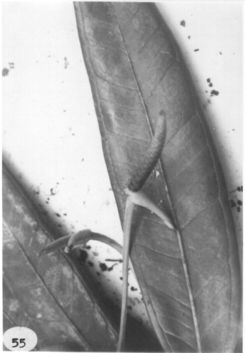






Selbyana 5: 323. 1981. TYPE: Panama. Col—n: Santa Rita Ridge, along trail at end of road to Río Indio, beginning 10.6 km from the Transisthmian Hwy., ca. 380 m, Croat 34301 (MO 2399063, holotype; K, PMA, US, VEN, isotypes; Live at MO).
LEAVES spreading; petioles 4-19 cm long, 5-9 mm wide, stiff, almost triangular, sharply acute abaxially, broadly and sharply sulcate adaxially with a faint medial rib; geniculum 1-2 cm long; blades oblong-elliptic, coriaceous, slightly arched along the midrib, acute to abruptly short-acuminate at apex (the acumen minutely apiculate), acute at base, 24÷40 cm long, 6-11 cm wide, broadest near the middle or slightly above, the margin flat or broadly undulate; upper surface glossy, lower surface semiglossy, with moderately dense, dark glandular punctations; midrib con-vexly raised above, narrowing and diminishing towards apex, sharply acute below, usually with a distinct, erect rib; primary lateral veins 20-35 per side, departing midrib at ca. 60° angle, slightly sunken above, obscure below, more or less straight to the collective vein; collective vein arising from the base, mostly straight, 5-7 mm from margin, slightly sunken above, obscure below.
INFLORESCENCE erect-spreading, shorter to longer than the leaves; peduncle 6-44 cm long, 4-8 mm wide, sharply triangular, the sharpest margin continuous with the decurrent edges of spathe, flexible to more or less stiff; spathe coriaceous, yellow-green, sometimes tinged purplish (B & K Yellow-green 7/10) at anthesis, lanceolate-elliptic to broadly lanceolate or oblong-elliptic, 3-11 cm long, 2.2-4.1 cm wide, broadest near point of insertion, short-acuminate at apex (the acumen hooked), acute and slightly inequilateral at base, decurrent 5-15 mm, inserted at 70° angle on peduncle, spreading, meeting on peduncle at 60-90° angle; the stipe 1-3 mm long in back, 6÷9 mm diam., darker green than peduncle; spadix pale green (B & K Yellow-green 7/10) at anthesis, 7.5-16.5 cm long, 8-13 mm diam. at base, 5-9 mm diam. at apex; flowers square or rhombic to weakly 4-lobed, 3-4.1 mm long, 2.5-3.9 mm wide, ca. 6 flowers visible m the principal spiral, ca. 5 flowers visible in the alternate spiral, the sides straight to shallowly sigmoid; tepals green, semiglossy, the lateral te-pals 2-2.2 mm wide; pistil weakly emergent at anthesis, pale green, the stigma oblong, with minute droplet just before pollen is visible, the droplets remaining after pollen appears; stamens never fully exserted, squeezing minute amounts of pollen out between tepals and pistil, the pollen held at edge of droplet; pollen white.
INFRUCTESCENCE spreading to pendent, the spathe much shorter than the spadix, spreading; spadix 12-24 cm long, to 2.5 cm diam.; berries subglo-bose, flattened at apex, pale lavender white, ca. 7 mm long, 6-7 mm wide, 4-5 mm thick, with a whitish circular area ca. 2 mm wide around the stigma; seeds 6, narrowly ovoid, white, ca. 2 mm long. Figs. 55, 56, and 58.
Anthurium dwyeri is known from Panama and Colombia (Choco) at 350 to 1,150 m in tropical wet and premontane rain forest.
The species is in section Porphyrochitonium and is distinguished by its coriaceous, oblong-elliptic blades that are punctate below, its sharply triangular petioles, its stout triangular peduncle, its pale green spadix, and its usually unexposed anthers that ooze pollen from beneath the tepals. It is also unusual because of its pale, lavender white, subglobose berries that are flattened at the apex. The species has no known close relatives. In rare cases, inflorescences are found that appear to lack stigmatic droplets and that have anthers exserted, laying flat against the pistil before opening. Both types of inflorescences were found on the same plant at the same time in the greenhouse at the Missouri Botanical Garden.
 |
 |
 |
Map of Mesoamerican specimens with coordinates
Costa Rica Heredia: 700-800 m, 10.17.30N 84.04.30W, 3 April 1986, Michael
H. Grayum 6699 (MO).
Panama CoclŽ: 400-600 m,, 16 Feb 1935, Hunter & Allen 576 (G).
Panama CoclŽ: 600 m, 8.45N 80.30W, 7 Feb. 1983, C. Hamilton & G.
Davidse 2868 (MO).
Panama CoclŽ: 200 m, 9.47N 80.28W, 9 Dec. 1983, H.W. Churchill, A.
Lier, W.S. Armbruster & A. Herzig 4010 (MO).
Panama CoclŽ: 200 m, 9.47N 80.28W, 9 Dec. 1983, H.W. Churchill, A.
Lier, W.S. Armbruster & A. Herzig 4011 (MO).
Panama Col—n: 500 m, 09.25N 79.40W, 17 September 1987, Gordon McPherson
11758 (MO).
Panama Col—n: 380 m,, 13 Apr. 1976, Thomas B. Croat 34301 (CM, MO).
Panama San Blas: 350 m, 9.19N 78.55W, 18 Nov. 1984, Greg de Nevers
4316 (MO).
Panama San Blas: 350 m, 9.19N 78.55W, 11 February 1985, Greg de Nevers
& David Cavagnaro 4832 (MO).
Panama San Blas: 30 m, 9.24N 79.24W, 27 March 1986, Greg de Nevers,
H.Herrera & S.Charnely 7591 (MO).
Panama San Blas: 350 m, 9.19N 78.55W, 8 March 1986, Greg de Nevers
& Heraclio Herrera 7279 (MO).
Map of South American Specimens with coordinates
Colombia Antioquia: Parque Nacional Natural "Las Orquideas", 1250-1375
m, 06.33N 076.19W, 31 Mayo 1988, A. Cogollo et.al. 3111 (JAUM).